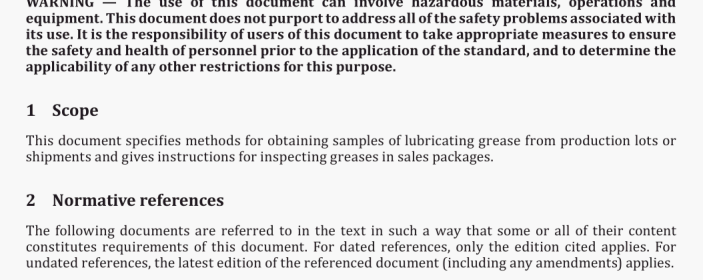Petroleum products

BS ISO 23572:2020 pdf free.Petroleum products一Lubricating greases一Sampling of greases.
The following documents are referred to in the text in such a way that some or all of their content constitutes requirements of this document. For dated references, only the edition cited applies. For undated references, the latest edition of the referenced document (including any amendments) applies.
ISO 3170:2004, Petroleum liquids — Manual sampling
3 Terms and definitions
No terms and definitions are listed in this document.
ISO and IEC maintain terminological databases for use in standardization at the following addresses:
— ISO Online browsing platform: available at https://www.iso.org/obp
— IEC Electropedia: available at http://www.electropedia.org/
4 General
The procedures described in this document are quite general because a wide variety of conditions are often encountered, and they may be modified to satisfy particular specifications.
Users shall proceed in accordance with ISO 3170:2004. Clause 6 and 7.2 pertaining to precautions, safety, care and cleanliness, except where there Is conflict with the instructions given In this document.
5 Sampling equipment
5.1 General
The sampling equipment described hereafter shall be chosen based on the observations done on the samples (control of the homogeneity):
— according to the size and type of container from which the sample is drawn; and
— according to the product and size of the sample.
5.7 Containers
The containers intended to receive the samples shall be clean and dry and non-corrodible by the sampled products. When the samples are stored over prolonged periods, the containers shall be resistant to the ambient conditions and well-proof lithe container has been obtained by crimping. The containers shall be able to be closed with a tight lid.
6 General measures
6.1 Sampling on the manufacturing site
If the inspection is performed on the manufacturing site, the samples shall be withdrawn from the containers ready for shipping separately on each manufacturing lot. Grease samples shall not be taken directly from grease kettles, cooling pans or tanks of processing equipment.
Do not sample the grease before it has stayed for at least 12 hours in the finished container and has cooled down to a temperature not more than 90 above that of the air surrounding the container.
If the same grease batch is packaged in containers of different sizes, treat the grease in each size of container as a separate lot.
6.2 Sampling on the delivery site
When the inspection is made at the place of delivery, obtain a sample from each shipment. If the shipment consists of containers from more than one production batch (lot number), sample each batch separately.
6.3 Sample size
Select containers at random on each lot or each shipment to give the required quantity as specified in Table 1.
7.1 Inspection
Examine the open containers to determine whether the grease is homogeneous. Compare the appearance, texture and consistency of the grease that stays in the vicinity of the surface with the grease located at least 15 cm below the surface. When more than one container of a lot or shipment is opened, proceed to the same examinations as before on all opened containers.
7.2 Sampling
If, when inspecting, no marked difference is evident, withdraw one portion from the approximate centre and at least 6,5 cm below the surface of each opened container in sufficient quantity to provide a composite sample of the desired quantity (see Table 1).
Withdraw portions with a clean spatula (52) and a ladle, big spoon or grain shovel (5,3) and place them in a clean container (5.7). For soft and very soft greases, it is preferable to use a ladle with a volume of approximately 0,5 1.
If there is any marked difference in appearance or texture of the grease from the various locations of an open container, take two separate samples of approximately 0,5 kg each, one from the top of the surface near the walls and the other from the centre of the container, at least 15 cm below the surface.
If any marked variations are noted between different containers of a lot or shipment, take separate samples of approximately 0,5 kg.
If, because a lack of uniformity, more than one sample of a batch or shipnwnt is taken, the samples shall be sent for laboratory inspection as separate samples.
7.3 Handling of grease samples
If more than one portion is required to represent a lot or shipment of grease with a penetration larger than 175 units of 0,1 mm tested in accordance with ISO 2137, a composite sample shall be prepared by blending aliquot portions thoroughly. This composite sample shall be prepared in a clean container, using a spatula, avoiding a too intense mixing and the inclusion of air bubbles.
As the grease samples become partially worked in being removed from containers, the procedure is not valid when unworked” penetration is determined.
7.4 PartIcular cases
When specific properties are determined on a product (e.g. thixotropic properties of a grease), the sampling process shall be performed following specific instructions made by the requestor of the analysis.
The sampling equipment of the products for which the structure shall not be disturbed (greases on which the unworked penetration is determined) shall be agreed upon.
7.5 Use of a ship auger
This type of sampling equipment is recommended for taking samples from any level of the product.
7.6 Use of a channel type auger
This type of tube is recommended when top samples, middle samples and bottom samples are taken.
7.7 Use of an Allen Auerbach auger
This type of tube enables the determination of the degree of homogeneity in a package. It also traps the layers of impurities at the bottom of a package that are not taken by the sampling equipment with nonclosed bottoms. The tube is introduced in the package in its open position, then closed and withdrawn.BS ISO 23572 pdf free download.Petroleum products